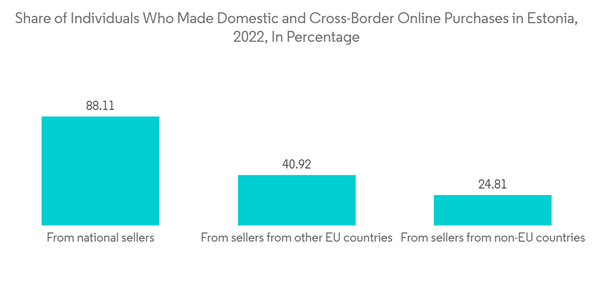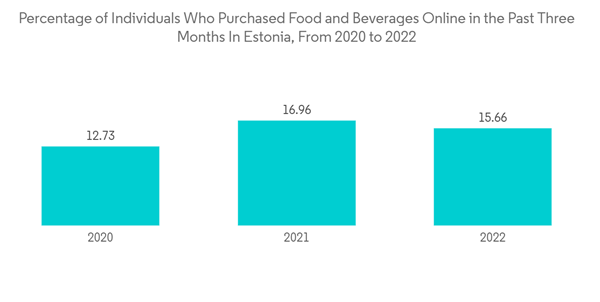Estonia's economic performance remains solid, supported by strong institutions and effective structural reforms. The World Bank Logistics Performance Index for Estonia improved in 2024 compared to 2018 Estonia is the geographical midpoint of Northern Europe, has one of the most effient trade routes from China to Northwestern Russia, and Northern Europe and the largest port at the Baltic Sea are all located in Estonia.
There is an increasing emphasis on transport development planning on its economy and environmental sustainability. The Estonian Ministry of Economic Affairs and Communications is beginning the inclusion of the Transport and Mobility Master Plan for 2021-2030. According to the Deputy Secretary of General for Transport, Ahti Kuningas, in the Estonian Ministry of Economic Affairs and Communications, the aim of the Master Plan for the next 10 years is to ensure a safe and technologically innovative transport sector while further developing the competitiveness of the logistics sector. With the country taking initiatives for growth in the green freight solutions and developing its trans European freight infrastructure, the importance of Estonia as a transit corridor has increased. Additionally, the government is taking initiatives to help develop the logistics infrastructure has been propelling the growth of logistics in the country.
Estonia Freight and Logistics Market Trends
Rapid Growth of E commerce in the Region
The online sales account for about one-fifth of total retail trade in Estonia and it is one the most important sales channel for many businesses in the country. E-shopping outside of Estonia has also grown rapidly in the last six to seven years, leading to growth in cross border e-commerce trade and increasing freight. The scope of Chinese e-commerce is demonstrated by the numbers of standard mail arriving from Asia, and it is noteworthy that the number of international items of correspondence has grown to 2.5 million items in the past five years.An average Estonian sends only one standard letter a year. This increase in standard letters by several million demonstrates only one thing; these are e-commerce purchases that are arriving in the mailboxes mainly from Asia, and without paying tax. The Competition Board said the three most prominent providers of courier service in Estonia, DPD, Itella, and Omniva, hold a market share of 80% combined, with DHL and UPS having another 10% between them. According to the association, the parcel volume of the five biggest courier companies is approximately 20 million units a year, of which nine million are cross-border parcels, and about half of the total parcel volume is moving via Omniva.Three of Estonia's biggest parcel delivery companies have seen increase in their delivery volumes due to the current epidemic and the measures taken by the Estonian government. In 2022, the majority of individuals in Estonia who had online purchased in the past three months bought goods from national sellers, at over 88 percent. In comparison, 41 percent of Estonians purchased products online from sellers from other EU countries.
Agriculture, Fisheries and Food Industry Growth in Estonia
According to Statistics Estonia, in 2022, fish farming enterprises sold 801 tonnes of commercial fish and crayfish, for a total of 4.9 million euros. The sale of fish roe amounted to 2.7 tonnes. The sold quantity of fish farming production decreased for the third year in a row. The quantity of fish roe sold in 2022 was 8 times smaller than the year before. According to Statistics Estonia, in 2022, fish farming enterprises sold 801 tonnes of commercial fish and crayfish, for a total of 4.9 million euros. The sale of fish roe amounted to 2.7 tonnes. The sold quantity of fish farming production decreased for the third year in a row. The quantity of fish roe sold in 2022 was 8 times smaller than the year before.The growth of agriculture, fisheries, and the food industry have helped the road freight transport industry in the country to grow at the time when the national haulers are experiencing heavy competition from international haulers. Digitization is a significant trend in Estonia, and the digitization of the road freight industry is expected to increase in the coming years. Platforms, like Uber Freight, are expected to emerge from within the country to help develop the market.
Estonia Freight and Logistics Industry Overview
The freight and logistics market in Estonia is fragmented in nature with a large number of international as well as domestic players active in the country. Some of the prominent players in the market include DHL, CEVA Logistics, DSV, Rhenus Logistics, and Group Logistics amongst others. With a lower cost base than Estonia, for instance, cheaper labor, fuel, and insurance, the number of service providers from neighboring countries, such as Latvia, Lithuania, and Poland, is high, driving down freight prices and giving tough competition to the local players.Additional Benefits:
- The market estimate (ME) sheet in Excel format
- 3 months of analyst support
This product will be delivered within 2 business days.










